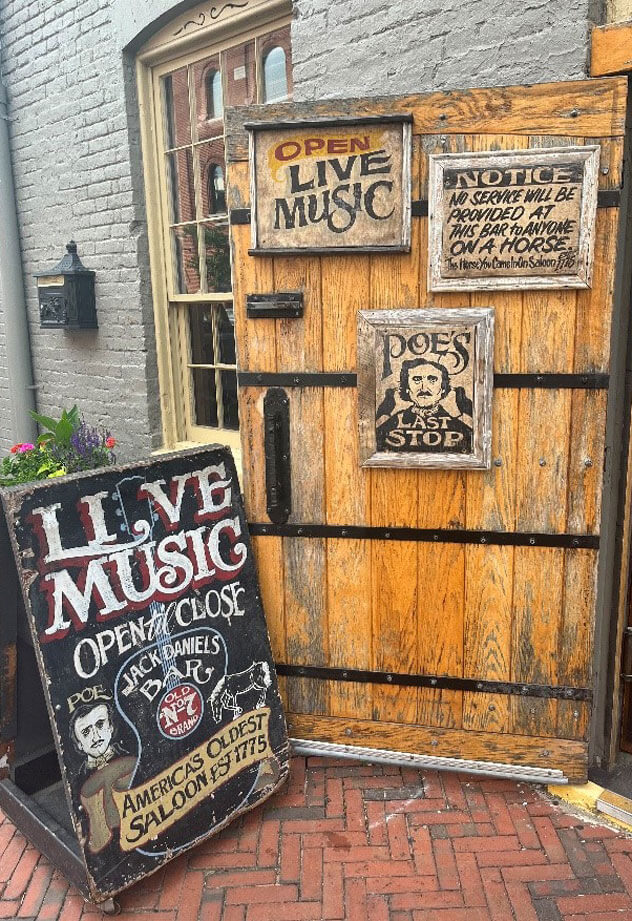Edgar Allan Poe enthusiasm at The Horse You Came in on Saloon in the Fell’s Point neighborhood of Baltimore. Photo: Margo Peyton
When I set out on two trips from my home in Baltimore this April, I did not know that I signed up for an Edgar Allan Poe interstate tour.
The first stop on my unintentional tour was Boston, where a statue of Poe with his coat blowing in the wind and a large raven by his side inhabited a corner near Boston Common. Poe was born Jan. 19, 1809, in Boston, where his parents were performing with a theater company. He had a tragic childhood — both of his parents died before his third birthday — and he was taken in by the Allan family in Richmond, Virginia. After some studies at the University of Virginia, a stint in the Army and at West Point, he moved to Baltimore in the 1830s, where he started writing short stories that followed the poetry he had already published.
Baltimore makes serious claims to the 19th-century poet and short story writer. The city is home to the Edgar Allan Poe House & Museum, the Edgar Allan Poe Society of Baltimore and his grave (which even had its own number listed in the Baltimore phone book). And, of course, Baltimore football fans voted to select the Ravens as the name of their new team in 1996. Much of the lore of Poe in Baltimore comes from his mysterious death. On a trip from Richmond to New York, he was found disheveled and confused at a Baltimore tavern and died several days later at the age of 40. Theories of his death abound, including rabies, a brain tumor, alcohol poisoning and murder.
Other cities, though, are not willing to forfeit their claims to the architect of horror. Poe’s work as a literary critic led him to live in many East Coast cities, including Philadelphia, where he wrote “The Tell-Tale Heart” and “The Fall of the House of Usher.” In 2007, Poe scholar Edward Pettit of Philadelphia encouraged his neighbors to drive down Interstate 95 to “appropriate a body from a certain Baltimore cemetery.” Pettit even debated Jeff Jerome, curator of the Poe House in Baltimore, who replied, “If they want a body, they can have John Wilkes Booth,” who is also buried in Baltimore. Other scholars argue that Richmond should house the writer’s burial site.
Despite the discord around Poe’s true home, according to an article in The New York Times, Boston is “the one city that probably will never claim Poe.” When biographers asked Poe where he was born, he answered that his family was from Baltimore. Even Poe would not acknowledge his Bostonian roots.
My next stop was Saratoga Springs, New York, for an American Association for the History of Medicine meeting. Poe published “The Raven,” the poem that earned him international notoriety, in 1845 in New York City. But he made a stop in Saratoga first. On a Haunted Saratoga Ghost Tour, I learned about a ghost cat, a hidden tunnel and the tavern where Poe is said to have written “The Raven.” The children of the tavern owners recalled Poe reciting lines of the poem aloud prior to 1845. Most likely, however, Poe wrote an early draft in Saratoga, which would be rejected for publication and spur a revision leading to its final form.
I can understand why so many cities showcase their Poe connection. A leader of the Romantic era in America, Poe elevated the genre of horror and macabre, and is cited as the first American writer to support himself through his writing alone.
For the last stop, I made my way back to Baltimore, the self-declared land of Poe, (n)evermore.
References
“Edgar Allan Poe in Baltimore.” Edgar Allan Poe Society of Baltimore, Oct. 28, 2019. eapoe.org/balt/poebalt.htm
The Raven. Edgar Allan Poe, 1845
“Baltimore Has Poe; Philadelphia Wants Him.” Ian Urbina, The New York Times, Sept. 5, 2008
“Did Edgar Allan Poe Really Write ‘The Raven’ in Saratoga Springs?” Sophia Perez, Saratoga Living, Feb 2, 2018
“Annals,” The Collected Works of Edgar Allan Poe — Vol. I: Poems, 529–72, Thomas Ollive Mabbott, 1969
Related Content
Want to read more from the Johns Hopkins School of Medicine? Subscribe to the Biomedical Odyssey blog and receive new posts directly in your inbox.
